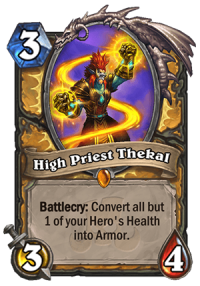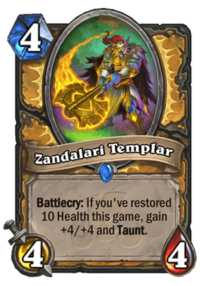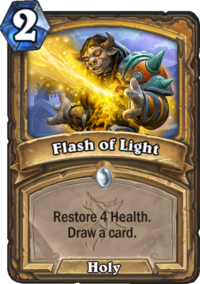Next to the Priest, Paladin was always seen as one of the two best healing classes in Hearthstone. Many of the best healing cards in the game were given to Paladin, and Control builds took a nice advantage of it, staying alive when they should have died a long time ago. Around Knights of the Frozen Throne, the designers have taken a new approach to healing. Instead of just a way to regain health, we’ve started getting some cards which synergized with healing and made it even more appealing.
Rastakhan’s Rumble tries to push the archetype to the next level, by adding both new ways to regain health, as well as more heal synergies. Will it be enough to successfully push the archetype into the meta, or will it be another failed attempt to make healing cards more relevant?
You’ll be able to find all of our pro and streamer lists on our Heal Paladin Archetype Page!
More New Rastakhan Archetypes
- Pirate Rogue
- Evolve Token Shaman
- Rush Warrior
- Odd Mage
- Dragon Warrior
- Elemental Mage
- Rush Warrior
- Big Beast Druid
Heal Paladin in the Past
Let’s be clear here, Heal Paladin is definitely not the most popular archetype in the history of Hearthstone, but it doesn’t mean that it didn’t exist. Here are two examples of the decks bearing that name, one from quite a long time ago, and a more recent second.
First, let’s start with this blast from the past – a deck list from over 2.5 years ago. At the time, Control Paladin was actually a quite decent option. “Infinite value” cards weren’t running around, Combo decks were heavily based on burn damage (so you could often counter them with healing), and Aggro decks were pretty common. Control Paladin builds were already heavily heal-based, but some players decided to push it even further and go for a deck tailored specifically to counter some matchups, where one of your main win conditions was basically outhealing whatever your opponent is trying to do to you.
You see, at the time, Paladin didn’t really have any “heal synergy” cards, just a lot and I mean a lot of powerful heal options. The deck used 11 healing cards, which was over the top even for a Control Paladin at the time, that’s why it was called “Heal Paladin”. However, the real heal-related cards didn’t start coming out until over a year later, in Knights of the Frozen Throne and Kobolds & Catacombs, with cards such as Blackguard and Lesser Pearl Spellstone.
And here’s the deck played by Kibler shorty after Boomsday Project’s launch. Of course, I won’t surprise anyone by saying that it wasn’t good enough, since it didn’t become a part of the meta (or even off-meta, for that matter). However, it shows quite nicely what we were dealing with going into Rastakhan’s Rumble.
Paladin has some ways to regain health, and some ways to synergize with those. But the problem is that healing cards aren’t necessarily amazing (even compared to the Whispers of the Old Gods list, when we had gems like Forbidden Healing and Ragnaros, Lightlord) and that healing synergies are difficult to trigger in lots of matchups, when you’re not taking damage. However, some of the cards have a serious potential if only they had more synergy. For example, Crystalsmith Kangor is quite insane in a Heal Paladin deck, doubling all your healing. But the problem is that his effect is often useless when you’re at or close to the maximum health. Similarly, Blackguard can get a lot of value, but in the matchups in which you need that kind of value, you’re often at full health, meaning that you can’t do anything with it.
Luckily for Paladin fans, a lot of those problems are going to be fixed in the upcoming expansion, that’s why theorycrafting Heal Paladin makes sense once again.
Heal Paladin Card Choices in Rastakhan’s Rumble
Heal Paladin has got a lot of support this time around, and it might even be enough to make the deck viable (maybe not high tier, but possibly a deck you can ladder with).

High Priest Thekal – Probably the best out of the Heal Paladin cards, Thekal is a solution to a problem Heal-heavy Paladin decks were always running into. Healing is great if your opponent is actively damaging you, but if you play against a slower deck that doesn’t do that? A lot of your cards are basically useless then. Thekal changes that. Playing him turns all of your health (but one, so you won’t lose the game immediately) into Armor. It means that you always end up at 1 health, with 29 missing. Which in turn means that all of your healing cards can be played even if you didn’t take a single point of damage from your opponent. Sadly, Thekal is only one-of, but we’ve got some other ways of damaging your Hero too.
Shirvallah, the Tiger – While it might not directly support the Heal Paladin deck, since it synergizes with spells and not necessarily healing, the card will make a good fit into slower Heal Paladins too. You see, you will be casting quite a few spells over the course of the game, getting Shirvallah cheaper and cheaper. And when you finally drop it, a 7/5 with Rush, Divine Shield and Lifesteal can do a lot of work. Rush and Lifesteal combination is also very powerful, as it can heal you for 7 the moment you drop it (or even 14 if you play it alongside Crystalsmith Kangor).

Zandalari Templar – Another healing synergy, and a quite powerful one at that. At first I thought that this condition will be quite hard to meet in slower matchups, where you don’t take much damage, but with the amount of cards that left you deal self-damage you can heal up again, I think that this card makes much more sense. It is similar to Hooked Reaver in a way (4/4 4-drop that turns into a huge Taunt when a condition is met), but in the right build, healing for 10 might be even easier than getting down to 15 health. And once you do, 4 mana 8/8 Taunt is a monster – both value-wise and tempo-wise.
Bloodclaw – You see, while Thekal seems to fix the problem, the thing is that you won’t always get him on curve or at least in the mid game. That’s why, for the sake of consistency, adding other similar cards might be advisable, and Bloodclaw is one of them. 1 mana for a 2/2 weapon is a really good deal – while it’s not absolutely broken, it will come handy for clearing the smaller early drops. Dealing 5 damage to yourself might seem like a huge downside, but it’s not necessarily one. If you run a deck with lots of healing cards, you will heal back up in no time, while triggering some synergies on the way.

Flash of Light – It’s a pretty simple, but effective card. Cantrips are always something to look out for. You see, a cheap way to draw a card while doing something minor can come handy for two reasons. First is obviously value – you did something without actually spending a card. Second is thinning your deck – by playing it, you get closer to the cards you need in a specific matchups. The card should come handy in Heal Paladin, as a way to trigger some synergies without even losing a card.
Soup Vendor – And finally, onto the Neutral options that fits into the Heal Paladin concept quite well. First one is Soup Vendor. Whenever you heal for 3 or more at once, which will apply to a lot of healing instances in this archetype, you draw a card. That said, 1/4 for 2 are quite weak stats, and since Paladin will have some other ways to draw cards, it’s hard to say whether it will make a cut in the end.
Ornery Tortoise – Tortoise is another card that might fit into Heal Paladin archetype. It’s basically the same concept as Bloodclaw – a card that is powerful for the mana cost, but deals 5 damage to you when you play it. But just like in the Bloodclaw’s case, damaging yourself can be a positive effect in this scenario, and a 3 mana 3/5 is not too shabby.
Heal Paladin in Rastakhan’s Rumble
I’ve prepared two different Heal Paladin deck lists. One is faster, leaning towards a Midrange build, which does run healing mostly for the sake of a mid/late game tempo swing provided by Zandalari Templar. Second is a slower, Control build that runs more synergies, and is looking for a much longer game.
Let’s start with the Midrange build. The goal of this deck is similar to any other Midrange Paladin build we had in the past. You want to play on the curve, dropping minions and buffing them, and in case you fall behind, you have your Equality combos to come back.
The deck’s main mid game win condition is Corpsetaker. Unless you draw poorly, the card should have all of the Keywords on the curve – Taunt, Divine Shield, Lifesteal and Windfury. While this specific build does not run Blessing of Kings to capitalize on it (I’ve tried to fit it, but I had a hard time), even without it it’s still a powerful play. Another good mid game play is The Glass Knight followed up by healing when the Divine Shield is down. Sometimes you can keep the shield up for multiple turns, getting many trades and outvaluing your opponent, or dodging AoEs and pushing face damage in slower matchups.
Another power play of the deck is obviously Sunkeeper Tarim. The card is insanely powerful and can win some games on its own. By buffing 2-3 of your minions and basically neutralizing any big threats your opponent might have dropped, the tempo swing is just insane. Spikeridged Steed is another strong T6 play – unless you run into Silence, it can turn a small minion into a solid threat vs Control or a big wall that will be hard to pass for Aggro decks.
The deck curves out with The Lich King, probably the best big Neutral threat available in the game right now. You drop a big body immediately (which might be hard to remove after your opponent already dropped his removal on your other stuff), which also adds extra cards. Some of them aren’t particularly powerful, but rolling AoE against Aggro or Frostmourne against Control is great.
As for the new win condition – Zandalari Templar is our guy. The goal is to either play High Priest Thekal or just take 10 damage (including Bloodclaws), and then restore 10 health in total. It doesn’t take a lot, especially if you can drop Crystalsmith Kangor. You will mostly do it through the Lifesteal effects, although every Truesilver Champion is 4 healing in total, and you can do it easily if Benevolent Djinn sticks to the board. And the pay-off is massive – 4 mana 8/8 with Taunt is great in any matchup. Against slow decks, it adds two big, high tempo threats, and against faster matchups it adds two extra Taunts they need to get through. Now, the question is – will they be consistent enough? That remains to be seen.
As for the other theorycraft, it’s a slower, more Control-oriented build. It doesn’t really try to win the games through pressure, although it has some ways to push the opponent in the late game.
Your basic strategy is surviving and outvaluing the opponent. The deck runs even more healing than the Midrange version, so surviving shouldn’t be a big problem most of the time. If things go south, you always have your Equality combos to clear the board, but I’ve also decided to add a single Shrink Ray, which can be quite powerful in certain matchups like Even Warlock. But against Aggro/Midrange, turning a board with five small-mid sized minions (15 damage in total) into a board of 1/1’s (5 damage in total) can also make a difference.
As for the late game package, the deck packs a few cool cards. Alexstrasza is pretty experimental in a deck like that, but it can be a great follow-up to High Priest Thekal. You get down to 1 health, and then Alex gets you back up to 15 – it can be a quite powerful play. Alternatively, you can use it to actively put pressure on your opponent. Given that in some matchups you simply can’t outvalue your opponent, putting pressure will be the only way to win. Other than that, the deck runs The Lich King I’ve already talked about above (below Midrange build), as well as Uther of the Ebon Blade and Shirvallah, the Tiger. As for the Uther, the deck can’t really OTK the opponent, but it’s not the point. Uther is mainly played for the weapon – 5/3 with Lifesteal can be an amazing way to heal up, and 5 extra Armor can save your life sometimes. Upgraded Hero Power (1/1’s are now 2/2’s) is also quite solid, plus you might force your opponent to clear the 2/2’s if you manage to stack 2-3 of them, or else he might lose the game.
And finally, I’ve decided to play the new Paladin’s Loa. I’m still not sure whether it will be a good decision, or rather whether this build runs enough spells to fuel it. Total mana cost of spells in this deck is 41, which is more than enough to get Shirvallah down to 0 mana. But the question is – will it happen fast enough for the card to be relevant? Because without a question, Shirvallah is powerful when you can get it down below 5 mana, but if it will take forever to do it, then having a dead card in your hand for the most part of the game is not a great idea. I feel like it’s one of those cards that you need to test out to really get a feeling of how fast you can get it down in what matchups and whether it’s worth it or not.
Oh, and of course, it also has 2x Zandalari Templar, meaning that you will be able to drop two extra 8/8’s in the late game. It might be one of your ways to catch the opponent off-guard – play one, then next turn if it survives drop Alexstrasza on him, getting him down to 7 while he stares at a massive minions on your side.
My biggest worry is that the days of infinite value Death Knights aren’t over yet. A few big threats would suffice in the past, but right now, in the era of cards like Deathstalker Rexxar and Frost Lich Jaina, it seems like the deck has no win condition in comparison. It’s true, and it will work better against Aggro and Midrange builds, which it should be able to outvalue. It might also be solid against certain Combo decks, such as Malygos Druid. High Priest Thekal will be a key in matchups like that (limited damage-based combos) – you will be able to go way past 30 health after you drop him, which is exactly what you want.
Closing
That’s all folks, thanks for reading. What do you think about those theorycraftings? Did you also think about this archetype? Will you What would you add or remove from those deck lists?
Be sure to check out our other theorycraftings, and hopefully we’ll see you in game when Rastakhan’s Rumble launches on Tuesday. Good luck on the ladder and until next time!














































Hey I really wanna make a paladin deck but not sure what would be the best rastakhan rumble one. The two I’ve seen that are looking hopeful are heal and control. I’ve already crafted Shirvallah so it would be more beneficial if I could find a deck that included that. Any feedback would be much appreciated, thanks!
Thanks for writing this – good article. Heal Paladin definitely seems worth trying.
Is it me or is Shirvallah not visible in the last deck?
You’re right, it disappeared from some reason (I was sure that it was there when I was building the deck). I’ve added it again, thanks for noticing!
Thank you as always for the great content!
Great Article, i’ve been testing a Control Heal Paladin the past month, and while it is a fun deck, it feels like its missing something to become a competitive deck. That’s why when i saw High Priest Thekal it felt like the perfect card to complete the deck.
I was wondering how you feel about adding the Lesser Pearl Spellstones (especially in the control version).
While i know it’s not the most exciting of the spellstones, even without the Rastakhan cards, its not that hard to play upgraded versions of them, and 2 mana 6/6 with Taunt is a nice defensive play, especially after you have played Uther of the Ebon Blade cos it makes it harder for your enemy to deal with the hero power minions that can’t be ignored for long..